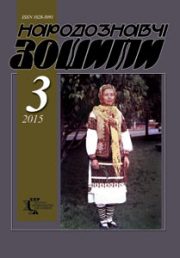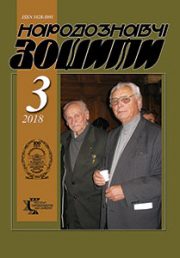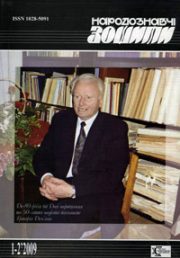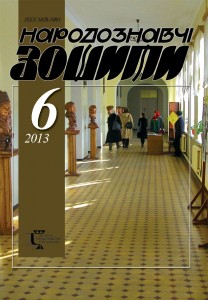2013 year, issue 6
Contents
The article has presented some popular proverbs and sayings expressing life principles, admonitions, and beliefs as for concepts of God’s will and providence. By exposure of semantic meaning in a number of popular paremies, the author has aimed to trace religious worldview in Ukrainians’ national character of ‘ thinking..
Keywords: paremy, proverb, saying, God’s will, providence, popular piety, popular outlook, mentality, religious consciousness, popular belief, thought form, popular wisdom, Christian doctrine.
Keywords: paremy, proverb, saying, God’s will, providence, popular piety, popular outlook, mentality, religious consciousness, popular belief, thought form, popular wisdom, Christian doctrine.
The article has analyzed some types of Ukrainian parody lamentations, functional peculiarities of this genre in the national lament tradition. The most popular is a parody crying for a mother-in-law and a husband. Parody cry have occurred as jokes within entertaining narratives. Those texts appear to be an audience’s reaction to insincere regrets for the dead.
Keywords: parody laments, joke, motif, comic effect.
Keywords: parody laments, joke, motif, comic effect.
Central point of the article is mid-1920s discussion on the system of administrative direction in the field of museum activities. Various approaches to the problem of tasks, principles and aims of museum work have been considered. The proof has been obtained that the problem of museum submission got quite hidden political essence. The author has shown that the majority of museum scholars tried to avoid direct dependence from the organs of ideological control and to spare wider space for qualitative scientific studies and traditions of work.
Keywords: museum, museum activity in Ukraine, state museum politics.
Keywords: museum, museum activity in Ukraine, state museum politics.
The article deals with attitudes towards issues of Ukrainian-Polish agreement in the publications of the newspaper «Hromadska Dumka». Under the Ukrainian-Polish antagonism, one of the leading Ukrainian Galician journals in a number of articles analyzed the possibility of understanding between the two nations, defined the key obstacles to reconciliation of the Ukrainians and the Polish, outlined the conceptual terms of normalization of relations.
Keywords: public opinion, social political life, political opinion, the Ukrainian-Polish relations, Rzeczpospolita
Keywords: public opinion, social political life, political opinion, the Ukrainian-Polish relations, Rzeczpospolita
Serebryakova Olena. Water symbolism in mantic customs of bridge-building. P. 994-998
Mantic rites with the use of water (hydromantic) belong to important components in all variants of maiden matrimonial divinations. The one of those is the custom of bridge-building. With the use of it a sleeping girl might see her future husband in dream. In the article have been analyzed symbolic contents, local variants and territories of spreading.
Keywords: divination (mantic practices), bridge, prophetic dream, crossover through water
Keywords: divination (mantic practices), bridge, prophetic dream, crossover through water
On the ground of own field ethnographic materials, sources and data of scientific literature the author has presented study in one of the areas of traditional culture, viz. the calendar ritualism. The article has brought some results of analyses in customs and rituals related to the autumnal calendar cycle.
Keywords: Ukrainians, autumn, calendar, custom, ritual, agriculture.
Keywords: Ukrainians, autumn, calendar, custom, ritual, agriculture.
The article has dealt with the problem of choice of the name for a new-born baby after popular folk beliefs, consuetudes and traditions along the territory of Opilia and the whole Ukraine, as well as among ancient Slavonic inhabitants of the land.
Keywords: Ukrainian tradition, name of the child, personal name, motivation of the name, Opilia.
Keywords: Ukrainian tradition, name of the child, personal name, motivation of the name, Opilia.
Some changes of traditional social roles within the families of Transcarpathian labour migrants during the early XXI c., particularly the crossover of parental duties to grandparents have been considered in the article. Especial attention has been paid to the roles of grandparents in mentioned families, as well as the relations between elder persons, «eurochildren» and labour migrants. Light has been thrown upon the notions of «surrogate fatherhood» and «substituting parents». The article has brought analytical study in the problem as for changes of traditional roles, when the souls of children of labour migrants, unlike the body, are created by grandparents. In the article have been exposed main ways for reciprocal support of grandparents and children in contemporary families of labour migrants.
Keywords: grandmother and grandfather, family of labour migrant, children, relations between grandparents and grandchildren, reciprocal help.
Keywords: grandmother and grandfather, family of labour migrant, children, relations between grandparents and grandchildren, reciprocal help.
The article has dealt with traditional Easter ceremonials by Ukrainians of Zhydachiv region. On the ground of his personal field ethnographic records the author has revealed some features of Easter celebrations via economic motives of those.
Keywords: economic motives, Easter, Zhydachiv region, ceremony, custom, attributes.
Keywords: economic motives, Easter, Zhydachiv region, ceremony, custom, attributes.
Shcherban Olena. Clay colander in ukrainians’ food culture: the shape and destination. P. 1033-1039
The article has presented first review of general peculiarities in forms and décor of clay colanders with description of their functional destination along various Ukrainian lands. Conclusion has been made that this kind of instrumental pottery, less widely used in Ukraine, had evident regional specificity in accordance with cookery traditions of any particular area.
Keywords: colander, form, décor, cookery.
Keywords: colander, form, décor, cookery.
The article has presented the origin of fundamental technical and scientific knowledge developed along the lands of ancient India. From the 3rd Millenium BC there had been performed significant efforts in the field of the urban construction. Notes have been made as for successes in the planning of ancient cities with sanitary utensils. Indian craftsmen were famous owing to their skill in jewelry, pottery, weaving. Processing of metals had got quite high level of development then. Mathematical theories had found their usage in elaboration of foundation for arithmetic, algebra and geometry. In astronomical observatories trained priests had carried out complicate observations on the motion of planets as well as on solar and lunar eclipses. The achievements of ancient Indians in medicine, especially in diagnostics, therapy, surgery are widely known today. Indian philosophers had laid grounds for a number of modern logic structures.
Keywords: Ancient India, science, technology, knowledge, culture.
Keywords: Ancient India, science, technology, knowledge, culture.
In chronological sequence the article has examined formation of Lviv suburban Horodok cemetery from its foundation in the second half XVII c. to the closure of it. Main reasons for foundation of cemetery as one of the first Lviv suburban ones have been exposed. A brief analysis in historical and artistic monuments of the cemeteryhfs been presented. Nowadays Horodok cemetery belongs to unsaved monumental memorial and cultural heritage of Western Ukraine.
Keywords: suburban cemetery, burial, historical and memorial heritage, monument of history.
Keywords: suburban cemetery, burial, historical and memorial heritage, monument of history.
An article has brought analytical review of ornaments in Western Ukrainian icons of late XV to XVIIІ cc. in the context of restoration research-works on icon painting. Stylistic evolutions of ornamental decorations in Ukrainian icons of mentioned period, origins of traditional background ornamenting in icons, main variants of background ornaments in Galicia and Volhynia icons have been presented and exposed.
Keywords: an icon, Western Ukrainian icon painting, background ornamentation, ornamental schemes, Eastern influences.
Keywords: an icon, Western Ukrainian icon painting, background ornamentation, ornamental schemes, Eastern influences.
Taras Yaroslav. On wooden sacral building of Moldova. P. 1058-1074
In the article have been considered wooden churches of Moldova and presented the typology of objects, drawings of their architectural planning and constructive designing.
Keywords: Moldova, wooden churches, Bukovina architectural school, bell-tower, western narthex.
Keywords: Moldova, wooden churches, Bukovina architectural school, bell-tower, western narthex.
The article has determined and presented some features of functional predestination in embroideries for shirts of Ternopil oblast during the XX c. The usage of embroideries with practical, ritual and protective ends has been discovered. Connections of technical and decorative tasks of embroideries have been exposed. Analytical studies in ethnical, territorially differentiated and age-produced traits of embroideries have been performed.
Keywords: function, folk embroidery, shirt, tradition, ornament, equipment, symbols.
Keywords: function, folk embroidery, shirt, tradition, ornament, equipment, symbols.
The article explores typology of glass beads decor of the 19th c. folk clothes from Bukovyna. Local artistic and compositional features of Bukovyna items have been determined.
Keywords: glass beads, decoration, glass beads decor, clothes.
Keywords: glass beads, decoration, glass beads decor, clothes.
This research-work has been an attempt to present an unfold review of Ukrainian temple fabrics – a kind of art with ancient roots and current revival. During late XX and early XXI cc. the self-taught amateurs as well as professional designers of textile and embroidery have studied and kept traditions of old Ukrainian sewing. Schools and workshops mentioned in this research-work possess certain experience that shall become a ground for further development of church artistry.
Keywords: embroidery, ornamental sewing, workshop, clerical garment, machine embroidery.
Keywords: embroidery, ornamental sewing, workshop, clerical garment, machine embroidery.
Sobolevska Nadiya. Decorated fabrics to the painting on fabrics. P. 1103-1107
In the article has been considered a kind of art, that appeared in Europe and during the XX c. was developed with due transformations from decorating fabric to painting on the fabric. With course of time the painting on fabric has overcome the frameworks of traditional craft and reached the level of decorative-applied art. In the second half of XX c. the strive to leave the utilitarian function has put forward a need to introduce another terminology in art studies.
Keywords: decorating, fabric, batik technique, painting, arts and crafts, transformation, dismissal, monumental painting, easel painting, direction, genre, style, fine art, new terminologi new.
Keywords: decorating, fabric, batik technique, painting, arts and crafts, transformation, dismissal, monumental painting, easel painting, direction, genre, style, fine art, new terminologi new.
In the article have been considered creative practices by the textil artists of Ukrainian artistic industrial weaving during the 2nd half XX c. The basic centres of flax, silk, woolen and cotton fabrics created by remise and Jacquard methods of production have been defined and characterized. Some artistic differences between fabrics for clothes and interiors have been put under analysis.
Keywords: textile artist, industrial weaving, desinator, colourist, assortment, decor, decorative pattern.
Keywords: textile artist, industrial weaving, desinator, colourist, assortment, decor, decorative pattern.
Three general hypostases of St. George have been put under analysis: those of martyr, patron, defender. Some changes in iconographic typology impacted by religious, political and social factors (and resulted with the appearance of martyr, warrior, rider) have been substanitated and presented. The images of St. George have been considered as for their expressiveness at different stages of religion devotion. The senses of those expressive approaches have been analyzed in works of Byzantine art.
Keywords: art studies, iconography, St. George, Byzantium.
Keywords: art studies, iconography, St. George, Byzantium.
The article has dealt with research-work on figurative, stylistic and thematic specificity in M. Kazas’ illustrative works of 1911—1913 as well as with study in peculiar features of artist’s creative method considered against the background of visual art and its development on the edge of XIX and XX cc. According to mentioned aims the artist’s personal biography and general cultural components of creator’s approach to illustrative series have analyzed as for evolution of creative styling, figurative and stylistic peculiarities in most interesting graphical and illustrative canvases.
Keywords: graphical art, illustration, creative method, textual interpretation, intermediation, stylization, decorative styling.
Keywords: graphical art, illustration, creative method, textual interpretation, intermediation, stylization, decorative styling.
In presented article has been examined creative works by Ukrainian artist, symbolist Yukhym Mykhailiv, whose paintings are preserved at the museum archives of the Ukrainian Cultural Center in Bound Brook New Jersey, USA. The artist’s creative heritage consists mainly of the pictures on the themes of national renaissance and subjects of Ukrainian history. The artist had also created a series of symbolic pictures on the philosophical themes.
Keywords: Yukhym Mykhailiv, symbolic art, national renaissance.
Keywords: Yukhym Mykhailiv, symbolic art, national renaissance.
Contemporary Ukrainian designers of fashion quite often turn their attention to the usage of national cultural motifs and folk art, so fine as decorative applied ones. That’s why in the following article some preconditions for specified use of ethnical styling in the works of Ukrainian designers have been considered and exemplified by creations of Martha Vasylivna Tokar, a Lviv fashion house artist. Particularly, there has been performed an analysis of Martha Tokar’s creative search in the context of Ukrainian national costume traditions of various ethnographical regions; the meaning of mentioned phenomena for further development of modeling art in Lviv during the 2nd half XX c. has been defined and presented.
Keywords: ethnical motives, creative search, Lviv fashion house, design of clothes.
Keywords: ethnical motives, creative search, Lviv fashion house, design of clothes.
In the article as less studied phenomena of Ukrainian art have been examined some specimens of the stained-glass works by the artists of Ivano-Frankivsk oblast appeared during the late XX and the early XXI cc. Technology, design, styling and colour featuring of creations by several artists have been determined and exposed. Main stages in development of stained-glass skill by the artists who have made quite substantial contribution in the progress of Ukrainian stained-glass artistry are traced.
Keywords: stained-glass, stained-glass artist, manner of execution, technique.
Keywords: stained-glass, stained-glass artist, manner of execution, technique.
In the article have been analyzed and discussed some creations by S. Hollosy in Tyachiv (contemporfry Transcarpathia) during 1902—1918. The features of creative and methodological approaches of the artist to traditions of painting in Transcarpathian area during the first half of the XX c. have been defined and exposed.
Keywords: S. Hollosy, creativity, artist, colour, painting.
Keywords: S. Hollosy, creativity, artist, colour, painting.
Mushynka Mykola. Mykhailo Hyryak as folklorist (in 80th anniversary of birth). P. 1165-1168
read »
Pashchenko Yevhen. Slavic studies that do not exist. Hryhorii Davydovych Verves. P. 1169-1172
read »
Kis’ Oksana. Valuable edition for Ukrainologists. P. 1173-1175
read »







